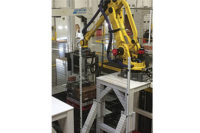Establishing the Optimal
Distribution Center Network
Ned Bauhof
Eighty percent of a
company’s supply chain costs are locked in during the design and
planning of the supply chain strategy. So when it comes to your network of
distribution centers, no matter how well your distribution centers operate,
if you have the wrong number of them or if they are in the wrong locations,
or serving the wrong purpose, your supply chain will be a drain on
finances. Therefore, before you invest capital in a new distribution center
or if the SCOR process recommends an evaluation of your distribution center
network, you should ask yourself the following questions: How many distribution centers should I have? Are there
opportunities to consolidate them? What is the role of each one in my
overall supply chain strategy? Are their locations consistent with my
supply chain strategy? Have I properly sized my distribution centers to
accommodate my supply chain strategy? Which products should I store in
which distribution center? Which customers should each of them service? Are
they flexible to accommodate future industry and customer demands?
A well-designed Logistics Network Model will help you
answer all of these questions and define what distribution centers are
required, where they should be located and how they operate to support your
overall supply chain strategy.
Network analysis
Put simply, network
analysis is the process of determining the appropriate facility
infrastructure to support a given supply chain strategy. This process
depends greatly on a variety of cost variables and operational constraints.
Cost drivers will vary depending on the scope and nature of the analysis
(i.e. single vs. multitier distribution) but generally can be categorized
as one of the following:
Inbound raw material sourcing costs.
Fixed costs at distribution
centers (and
production facilities, if applicable).
Variable costs at distribution centers (and production
facilities, if applicable).
Inventory carrying costs.
Replenishment and transfer
freight costs between facilities.
Outbound freight costs from distribution centers to
customers.
Operational constraints are business requirements to
which you must adhere – regardless of the cost. You can violate these
constraints only if you’re willing to pay a specified penalty.
Constraints can vary widely but generally include the
following:
Facility status (will definitely remain open or will
definitely close).
Facility eligibility (what is the capability of a
given facility, and/or which SKUs can you place in a given facility?).
Facility storage and
throughput capacity.
Customer service requirements.
Sourcing requirements
(sole source for customer shipments vs. split shipments with another
facility).
Minimum and maximum number of facilities.
Demand profile constrains the analysis (customer
location and product mix) as well as the number and type of alternative
scenarios under consideration.
Modeling tools
In most cases, the need to consider myriad
alternatives, to simultaneously evaluate multiple cost variables and to
honor a host of constraints makes most problems
too difficult to solve using traditional methods such as a calculator or
spreadsheet. Determining an optimal solution, typically based on the least
cost or maximum profit, requires the use of a network modeling tool. Most
commercially available tools consist of three primary components: a user interface that accepts the
various demand, cost and constraint data; a translator that converts this data into representative mathematical
functions; and a solver, which is the analytical engine that determines the solution.
Solvers utilized by more robust modeling tools employ specialized mixed
integer linear programming theory (a complicated explanation too lengthy
for the space allotted to this article) to calculate the true optimal
solution and, therefore, are referred to as “optimizers.” Most
commercial tools also provide significant statistical and graphical
reporting functionality.
Modeling vs. analysis
Many people think of network modeling as being
synonymous with network analysis. In reality, modeling is only one
component of the network analysis process. I make this distinction because
there is often a misconception that an all-knowing model can be constructed
to identify the one true optimal network. In reality, a model is simply a
mathematical tool. The burden still lies with the user to develop
alternative operating scenarios, provide input data for each scenario,
correctly interpret model results and account for qualitative issues such
as risk management, human resources and sales and marketing implications.
Benefits
The first benefit at the top of everybody’s list
is cost savings, and for good reason. However, there are several other
legitimate benefits to undertaking a network study; not the least of which
are the unexpected benefits resulting from the interdepartmental dialogue
and interaction mandated by such an exercise.
Cost Savings: The general rule of thumb for savings opportunities
associated with network analysis is 5 percent to 15 percent of those
logistics costs that the study can influence. This will obviously vary from
case to case and assumes that the current network is suboptimal. It also
depends on your ability to institute change within the network. For
example, if a particular distribution center must remain open to honor a
contractual agreement, or the head of a family-owned business chooses to
safeguard the plant where he founded the company, it might be possible to
reduce cost-savings opportunities. They often come in the form of cost
avoidance rather than cost reduction. Many studies begin in an effort
to locate new facilities in order to support planned volume growth or new
market penetration rather than consolidate facilities to reduce cost. In
this situation, it is difficult to quantify savings because there is no
clear benchmark against which to compare the recommended solution.
Customer Service: Customers are becoming more
demanding in their order-to-delivery requirements. The number of orders is
increasing, the size of the orders is decreasing, willingness to accept
imperfect orders is decreasing, and the management of delivery windows
continues to tighten. Analysis of an optimized distribution center network
can be constrained by these demands and will generate a solution that will
support customer service requirements through sensitivities to lead time
and order fill rate requirements.
Budgeting Tool: A network
model can also serve as a budgeting tool for projecting future capital and
operating cost requirements. As part of this budgeting process, a network
model can quickly test alternative operating scenarios as well as predict
the impact of acquisitions, new product introductions and other business
changes that could occur during the next budget cycle.
Communication: In some companies, the biggest value of
network modeling is that it serves as a catalyst to encourage dialogue
between individuals from across the organization. Network modeling requires
participation from all functions that impact, or are impacted by change to
the distribution center network. As these individuals focus on the
organization at large and voice their various concerns, new insights and
knowledge always result.
Modeling requirements
In order to conduct a quality network analysis,
significant effort must be dedicated to the collection and validation the
various data elements. Also, give thought to the aggregation and
representation of data within the model. Modeling generally occurs at a
product group rather than an SKU level, with customers typically being
aggregated by type and geography. In the end, there are three fundamental
drivers to any network analysis: demand, costs and constraints.
Demand: Demand data describe the customer base and
associated order volume and profile. You can typically glean this data from
historic customer shipment data, ideally across a 12-month time period in
order to capture seasonal demand patterns. You can aggregate the
information as necessary to determine the allocation of volume by product,
customer class, geography, and transportation mode. To obtain future state
volume, product mix and allocation changes across customer, geography and
transportation modes, you must select a design year (typically three to
five years).
Costs: The number and types of cost data will vary
depending on the scope of the analysis. In general, costs are either fixed
(independent of demand) or variable (a function of demand). Fixed costs
include capital investments and overhead expenses such as facility leases and administrative labor. Variable costs are generally synonymous with operating costs such as direct
labor and transportation. Some costs, such as inventory carrying costs, are
arguably comprised of both a fixed and variable component, and you can
model them as such. One of the model’s
tasks is to perform the trade-off analysis
between fixed and variable costs.
A simple example is the decision to open an additional
distribution center. Assuming that operational constraints do not force the
opening of the facility, it is only justifiable if the variable cost
savings that it provides offset the fixed costs required to open it. Fixed
costs will increase as a result of the facility, equipment, administrative
labor and inventory associated with the distribution center. However, the
facility should reduce outbound transportation costs, while inbound
transportation and variable facility costs may or may not decrease. If the
operational cost savings offset the fixed expense, the facility receives a
recommendation, otherwise it will not.
In some instances, cost data may be difficult to
acquire, particularly when there is a need to allocate costs by product
group and/or customer classification. Typically, you can derive
manufacturing and distribution costs from site-specific operating
statements. Aggregated transportation costs are obtainable from the same
sources.
Constraints: Constraints are user-imposed requirements
placed on the model that override cost considerations. Constraints can take
on a variety of forms, but four are more prevalent than most. The first are
capacity constraints placed on production lines, plants or distribution
centers. The second are eligibility constraints. Eligibility precludes a
dry distribution center from shipping refrigerated product or a can line
from producing bottles. The third are customer service constraints. They
mandate a maximum travel time or distance to customers. Service constraints
often force the opening of facilities that would not otherwise be justified
on the basis of cost. The fourth are open/closed constraints. These
constraints establish a minimum or maximum number of facilities and
identify specific facilities that require closure or must remain open.
Challenges
The two biggest obstacles to a successful analysis are
the availability of operating data and the ability to maintain focus on the
objectives of the study. The latter is primarily a project management
issue. Due to the number and variety of individuals participating in the
study and their particular areas of interest, a network analysis can easily
veer off course in attempts to address any number of issues for which it is
unsuited.
Issues with operating data, on the other hand, are
generally out of everyone’s control. In addressing data shortfalls,
there are generally three methods of resolution. The first is to confirm
that the data is truly necessary. In the
context of a long-term strategic analysis, less-than-perfect data do not
necessarily compromise the study and can still yield results which are
directionally sound. The second is to develop work-arounds for missing
information. These work-arounds take on many forms but are essentially
best-guess assumptions in the absence of concrete information. Finally, for
data that is critical to the analysis, you must make additional effort,
often manually intensive, to derive the needed information.
Keys to success
A successful network analysis project boils down to
data and personnel. The data required to perform the analysis must be
accurate and accessible. It may be somewhat assumptive, but it must not compromise the integrity of the analysis. It must
garner confidence from the management personnel because they will have to
act upon the recommendations.
More important than data are people. First, an
experienced, analytically minded person(s), from within or outside the
organization is necessary to process the data, construct the model and guide the process. Second is a project team
comprised of knowledgeable people from across the company who are capable
of addressing the various business and logistics functions impacting the
study. Third is upper management support.
A network modeling effort can easily be misconstrued
as something it is not as well as lend itself to excessive amounts of
what-if analysis. This is avoidable early in the project by explaining the
strategic nature of the process, addressing the limitations of a network
model and clearly defining the goals and objectives of the study.
In an ideal world, you will pursue the development of
an optimal distribution center network so that the quantity, location and
purpose of each facility are empirically correct and understood by your
organization. The capability of modern-day analytical models is
astonishing. Whether performed via internal staff or through the use of a
consultant specializing in network modeling, models give you the power to
evaluate millions of cost variables, hundreds of operating scenarios and
virtually every network or business sensitivity and “what-if”
scenario. Having this definitive empirical information is the foundation
for distribution center design, real estate transaction, financing and all
of the other components which are required to achieve a cost- effective
distribution center network and satisfy or exceed customer demands.
I would like to thank Mike Jones, a principal with the
St. Onge Co., for his invaluable assistance in the preparation of this
article. BI






